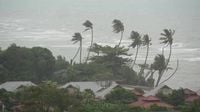When Super Typhoon Fung-wong barreled into the Philippines in early November 2025, the country found itself once again at the mercy of nature’s fury. In Metro Manila, as the storm’s violent winds howled and rain battered the city, a driver’s dashcam captured a moment both terrifying and surreal. An electrical transformer exploded in Quezon City, sending a shower of burning debris and bright flashes across the road. The footage, quickly shared across social media, became a stark symbol of the chaos unfolding across the archipelago as millions struggled to stay safe.
But this was only one fragment of the devastation. According to reports compiled by international relief organizations and local authorities, Super Typhoon Fung-wong was the second powerful storm to strike the Philippines in just one week, following closely on the heels of Typhoon Kalmaegi. The twin disasters left at least 25 people dead and forced more than 1.4 million residents from their homes. The government responded by declaring a year-long state of national calamity, a measure intended to speed up recovery and unlock emergency resources for the battered nation.
For many Filipinos, the storms were a grim reminder of their country’s vulnerability to extreme weather. Floodwaters swept through entire communities, submerging farmland and burying villages under thick layers of mud. According to World Vision, a global humanitarian aid charity, the destruction was widespread and urgent support was desperately needed. Operations manager Roberto Dazo summed up the mood, saying, "Back-to-back storms are stark reminders that climate change is an everyday reality for millions of Filipinos."
In the face of disaster, stories of resilience and ingenuity emerged. One family in the Philippines, still haunted by memories of losing many chickens to severe flooding during a previous typhoon earlier in 2025, took extraordinary measures to protect their flock as Fung-wong approached. A video that quickly gained traction online showed their solution: rows of chickens, each cradled in a fabric holder, suspended from wooden beams inside their home. The family had cleared the area beneath the roof and methodically secured each bird, transforming their living space into a makeshift aviary. As the storm raged outside, they monitored the chickens closely, lowering them one by one after the typhoon passed to check their condition. Miraculously, every chicken survived unharmed—a small but meaningful victory in the midst of widespread loss.
Such acts of resourcefulness were echoed on a much larger scale by the country’s faith communities. Christian organizations, both local and international, mobilized rapidly to provide shelter, food, and hope to those displaced by the storms. Roman Catholic Archbishop of Cebu Alberto Uy issued a call to action, instructing parishes across the region to open their doors and support affected families. "Let us be living witnesses of God’s mercy," Archbishop Uy urged. "When we help, comfort, and accompany, we become instruments of hope."
In practical terms, this meant that church buildings—often among the sturdiest structures in many neighborhoods—became lifelines for evacuees. The Church of Jesus Christ of Latter-day Saints opened nearly 90 of its facilities as makeshift evacuation centers, distributing food, clean water, and hygiene kits to families who had lost everything. Coordination between church leaders and local disaster relief agencies helped ensure that aid reached those most in need, even in remote and hard-hit areas.
International Christian relief groups also responded with urgency. World Vision’s teams worked around the clock to deliver essentials and assess the damage, while the World Council of Churches sent a letter of solidarity and encouragement to Filipinos enduring the storms. Rev. Prof. Dr. Jerry Pillay, representing the Council, wrote, "We stand alongside you as you continue to be living signs of God’s compassion, presence, and justice." He went on to stress the broader implications of the disaster, urging global action on climate resilience. "The increasing frequency and intensity of weather-related disasters remind us of the urgent need for faithful stewardship of creation," Pillay said.
The government’s declaration of a state of national calamity underscored the scale of the crisis. This rare step, which unlocks special funding and eases regulatory barriers for relief operations, reflected the extraordinary challenges facing the country. With more than 1.4 million people displaced, many found themselves in crowded evacuation centers, reliant on the generosity of strangers and the efficiency of relief agencies. For those who lost homes, livelihoods, or loved ones, the road to recovery will be long and difficult.
Yet, even as the storms exposed deep vulnerabilities, they also revealed the strength of community bonds. In neighborhoods where power outages and flooding were the norm, residents banded together to clear debris, share supplies, and offer comfort. The viral video of the family’s suspended chickens became a lighthearted symbol of Filipino ingenuity—a reminder that even in the darkest moments, hope and humor can survive.
Meanwhile, the destruction of infrastructure—such as the transformer explosion in Quezon City—highlighted the urgent need for investment in disaster-resistant systems. Urban planners and engineers have long warned that Metro Manila’s aging electrical grid and flood defenses are ill-equipped to withstand the growing intensity of storms. As climate change drives more frequent and severe typhoons, calls for comprehensive upgrades and resilient infrastructure have grown louder.
For the millions affected by Typhoon Fung-wong and its predecessor, the focus now turns to rebuilding. Christian organizations, government agencies, and international partners are working in tandem to restore homes, rehabilitate farmland, and provide psychosocial support to those traumatized by the events. The lessons of 2025—both the heartbreak and the heroism—will shape how the Philippines prepares for the next inevitable storm.
As the nation moves forward, the words of Archbishop Uy resonate across the archipelago: "When we help, comfort, and accompany, we become instruments of hope." In the Philippines, hope is not just a feeling—it is a collective action, forged in the crucible of adversity and carried forward by the hands of ordinary people.


